Glass Countertops Review & Buyer's Guide
Glass countertops have jumped into the mainstream in both bath and kitchen design as people get more creative and thoughtful about the style of their home.
Unconventional countertop shapes, embedded artistic designs, backlighting, as well as other lighting effects are some of the unique options available when designing with glass that really grab attention and provide that “wow” factor.
Glass is more durable than you might think and stands up well to daily use. However, like any countertop material, there are pros and cons to glass countertops. I'll explore all in detail for you below.
On This Page
- Types of Glass
- Pros & Cons of Glass Countertops
- Recycled Glass Countertops
- White Glass Countertops
- Glass Countetop Color & Design Options
- Glass Countertops Cleaning & Maintenance
- Glass Countertops Cost
- Installers & Suppliers
- Conclusion
Types of Glass
First a little education about the types of glass, different treatments, and how it is formed so you know what’s what when considering this type of countertop.
Glass has been an integral part of interior design and home renovations for years. Often the combination of stylistic choices and the durability of the material have come into play for homeowners and designers.
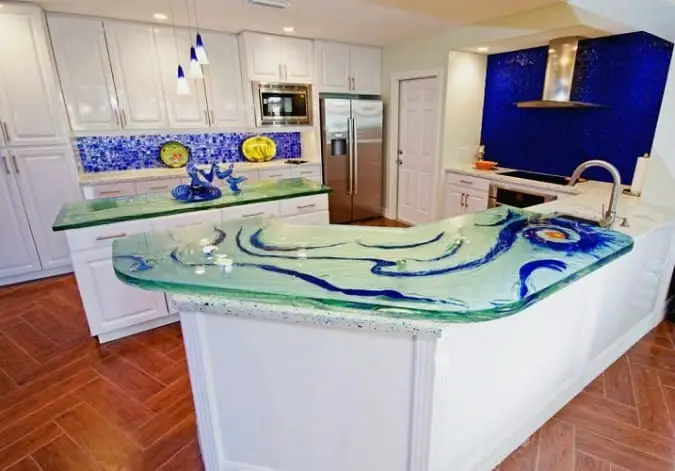 Color infused glass countertops | Image Source: Downing Designs
Color infused glass countertops | Image Source: Downing DesignsAs they say, not all glass is created equal, and the various types of glass and how it is formed can affect the durability and design of your countertop installation. Also, note that a recycled glass countertop is a different surface than what we are discussing here.
Glass Treatment Options
Through trial and error, as well as educated experimentation, glass manufacturers have discovered different ways that certain treatments can help the strength and durability of glass.
The tensile strength of glass can be increased through temperature processing that can help with longevity and durability.
Tempered Glass Countertops are made when a piece of glass is uniformly heated and then rapidly cooled. By controlling the pressure and tension on the outer surface and interior surface, it creates a type of glass that is five times stronger than non-tempered.
Consider all of the glass-topped electric stoves; it can withstand a lot of heat as well.
Most glass used in architectural applications is tempered, but it is important to check with your supplier to see if the glass specified for your kitchen remodel is tempered or not.
Non-Tempered Glass is simply glass not treated in the same way as tempered glass. It is often considered untreated glass and not really suitable for a kitchen countertop.
Annealed Glass is glass that has a chemical added to it to increase its strength and durability. It is not as strong as tempered glass, nor is it as vulnerable as non-tempered glass. While it does go through a particular process of cooling to retain strength and durability, it does not have the heat resistance that tempered glass does.
How is Glass Formed
Once your glass countertop supplier has determined the type of glass they will use in your home improvement project; they will then create a template of the shape of your kitchen countertops, and determine the best way to form your glass.
Float Glass is created by floating molten glass over a piece of molten metal. This creates a flat surface and a uniform thickness. It is one of the most common ways that windows are created.
Slump Glass is where a piece of glass is placed in a mold, and heated at a rapid rate until it is orange/red and molten. Then through the force of gravity, the glass slowly slumps down into the shape of the mold. This method often requires the mold to be slightly oversized to take into account the shrinkage of the glass as it cools.
Kiln Fired Glass is a process that places the mold into a kiln where it is fired until the glass pieces fill the mold. This process is limited by the size of the kiln but has the bonus of being able to use broken or recycled pieces to create the slab for a countertop.
Pros & Cons of Glass Countertops
When it comes to picking kitchen countertop surfaces, there will be both benefits and drawbacks to any material. Here are the key points which are then discussed in detail after.
Note: “white” glass is a special type of glass with different characteristics as indicated. Learn more about white glass below.
Benefits of Glass Countertops
- Very good Durability
- Easily cleaned
- Low day-to-day maintenance
- Heat tolerant
- Stain resistant
- Custom designed size, shape, colors & patterns (white glass is only white and smooth)
Disadvantages of Glass Countertops
On the alternate side, there are a few drawbacks to having glass counter tops, and this is a consideration that must be taken with any countertop material (including marble, quartz, or granite).
Your countertops are one of the most used surfaces in the home (besides the floor), it will have a lot of wear and tear, which might result in the following issues:
- Fingerprints and smearing can be visible across the surface.
- Contact with acidic foods, drinks, and certain cleaners can damage the surface and require fixing (except white glass).
- Scratching, nicking, cracks, or breakage are more common than other materials. This includes tempered glass, but white glass is harder to scratch or chip.
- Higher cost to install and repair in comparison to other countertop surfaces.
- Textured surfaces will be harder to clean (but usually texturing is done on the underside of the countertop).
Recycled Glass Countertops
With more and more kitchen remodel project having a distinct focus on sustainability, eco-friendly and green design, it is important to also examine recycled glass as a countertop choice.
But note… a “recycled” glass countertop is not the same as a “glass” countertop.
A glass countertop is one solid piece of pure glass. It can be made with pieces of recycled glass melted into a solid single piece but it is not typically referred to as a “recycled glass countertop”.
In contrast, recycled glass counters are created by combining glass fragments or crushed glass with various binders. It's a a man-made or “engineered” surface like quartz or Corian countertops.
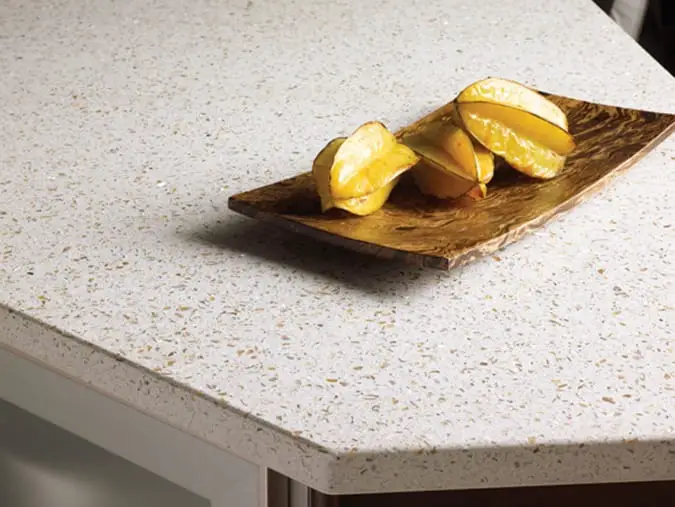 Recycled Glass Countertop | Image Source: Ice Stone USA
Recycled Glass Countertop | Image Source: Ice Stone USAMuch like the first examples of terrazzo flooring was created in 9,000 BCE with fragments of marble set in a bed of clay, recycled glass fragments can be placed in a resin or cement binder to create a mottled and colorful countertop.
The benefit of this method is the broad range of color choice that you have at your disposal. You can choose from a combination of recycled glass colors as well as the pigmentation of the binder.
It can have a very clean and contemporary look that resembles some quartz countertops. Although, pattern options are basically limited to a sort-of pebbled appearance.
A concrete based binder for your recycled glass countertops will require a sealant application every so often. As is true with most concrete countertops, it will have some staining with certain foods and oils.
A resin-based binder will stand up to stains as well as wear and tear. It is similar to choosing quartz countertops in regards to aesthetics and durability.
Recycled glass countertops are pretty durable resisting stains and scratches, but hot pans should not be set directly on the surface and etching from acidic foods and drinks can sometimes be a problem.
Now that you have a good idea of the difference between solid glass and recycled glass, I’ll continue discussing pure glass surfaces.
White Glass Countertops
And for another twist… “white” glass is a special breed of solid glass countertops that have different qualities. White glass counters are similar to nano glass countertops.
It looks like a white quartz countertop but it is more durable than quartz or granite.
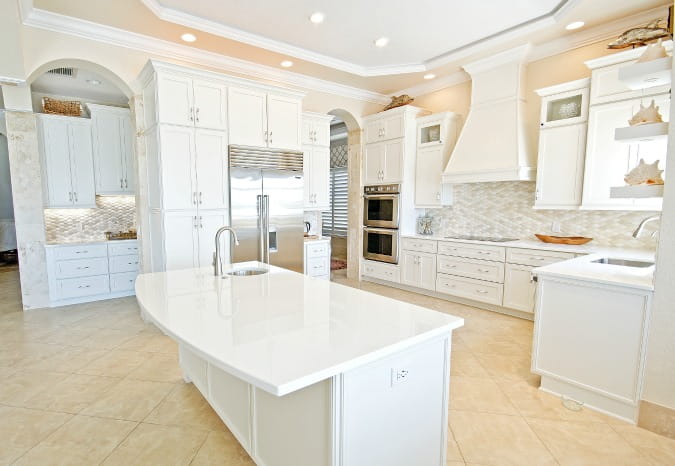 Image Source: Downing Designs - White glass countertops
Image Source: Downing Designs - White glass countertopsWhite glass countertops are formed using a mix of glass and silica and fired at a super-high temperature of 2700 degrees celsius.
The result is a glass surface with incredible durability and performance characteristics (different and better than standard glass counters) including carefree cleaning and maintenance requirements.
- Stain-proof and no sealing required
- Does not etch from acids like standard glass counters
- Does not burn or scorch from hot pans
- Very difficult to scratch or chip
- The color is very pure white (but that’s the only color)
- Stays cooler than granite for outdoor kitchen countertops
- Surface is extremely smooth and shiny
Limitations of white glass countertops….
- They are expensive ($150 - $250 / sq. ft.) as cutting, polishing, and installation requires specific experience and skill.
- Cannot be backlit for lighting effects
- Cannot include other colors (white only)
- No texture or pattern
Glass Countertop Color & Design Options
Unlike natural stone that is harvested as is, glass is a material that is formed and created based on your design desires. The customization options available with glass countertops are far greater than any other surface type.
Some creations are really functional art pieces.
Now the more you customize the more expensive it will be, but you can create a truly dramatic focal point that makes your countertop a show stopper in your home.
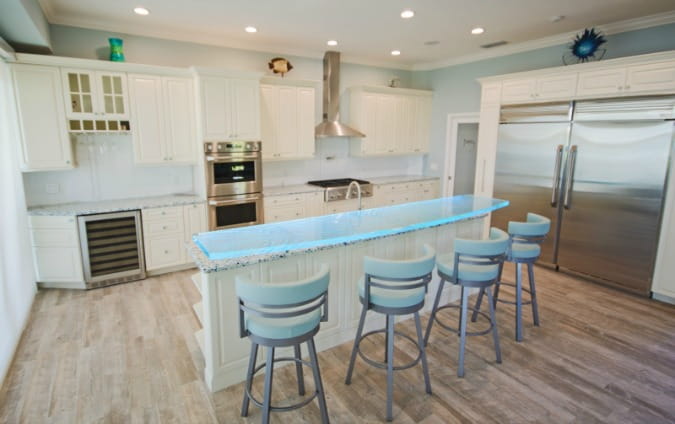 Image Source: Downing Designs
Image Source: Downing DesignsYou can go big or small, thick or thin, create interesting shapes, textures, and colors. Below are a few variables to take into consideration for your kitchen remodel and custom glass countertops.
Colors
The colors for glass surfaces are fairly wide-ranging: blue, brown, red, yellow, green, black, white, and clear glass countertops are all possible.
The countertop can be one solid color or include a mix of colors in a custom pattern or swirls.
- Again… except for “white glass countertops” which are only solid white with no pattern or texture.
You may choose to have a transparent glass or a more opaque look.
An excellent way to incorporate stunning colors is to have inclusions of color placed within the field of clear or lightly colored glass. The color seems to float inside the countertop which brings interest and pops of color to your kitchen design.
Surface Choices
Because the top surface has the important position of being a clean surface for cooking, any texture is often incorporated into the thickness of the glass or added to the underside of the countertop.
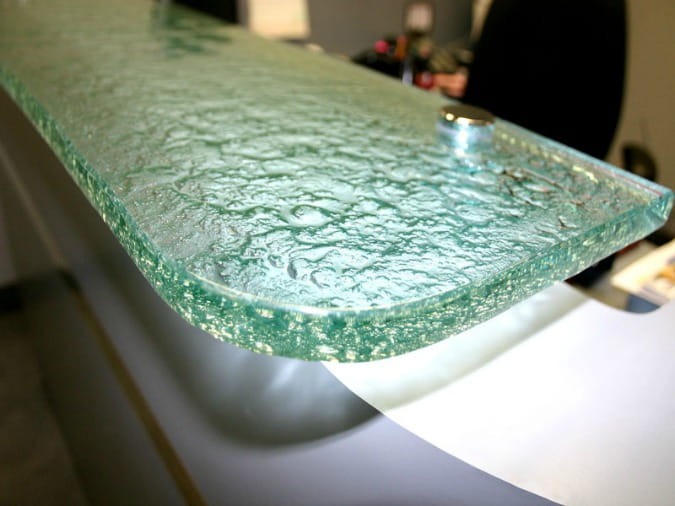 Textured Glass Bar Top | Image Source: CBD Glass Studios
Textured Glass Bar Top | Image Source: CBD Glass StudiosWaves, bubbles, and ripples are commonly incorporated into the bottom surface of the glass. Because of the clarity of the glass, it can be viewed from above.
The thickness of the glass gives depth to any texture that is added to your design.
Finishes
One favorite finish type is having a milky or etched finish on the bottom of the countertop and a clear finish on the top. This brings visual depth to the glass and has the dual purpose of not exposing the underlayment or cabinetry below.
It also disperses light well and gives a beautiful inner glow to your countertop.
The top surface can be etched as well for a frostier look, but any nicks or scratches will show more clearly with this finish type.
Edge Styles
Similar to other countertop materials, there are a variety of edge styles to choose from.
You might consider a classic bullnose edge, eased edging, a squared edge, or anything in between.
If you want to draw attention to a particular feature area, you might consider a wavy edge or an artistic edge.
Lighting Effects
Possibly the most unique and cool feature of glass kitchen countertops is the ability to include various lights to dramatically emphasize the colors and textures of the glass.
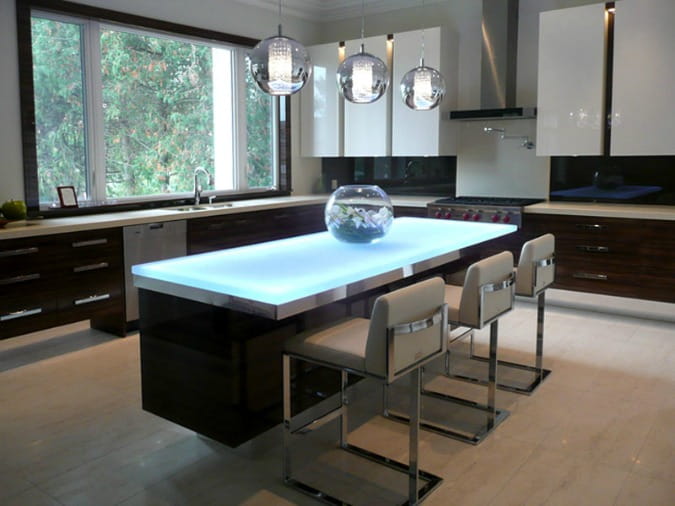 Backlit Clear Glass Countertops | Image Source: CGD Glass Countertops
Backlit Clear Glass Countertops | Image Source: CGD Glass CountertopsBacklights from under the surface, sidelights around the edge, spot lights, and colored lights can be incorporated into any custom glass countertop design to draw the eye.
Design Tips
When it comes to design considerations, it is important to take into account your lifestyle, the level of traffic you will have in your kitchen, as well as the long-term plan for your home.
- Whether or not you are entertaining regularly, have young children, rarely use your kitchen, or use your kitchen a lot will play into the design of your countertops.
- Many people use glass countertops in a featured area as a highlight. You might have a bar or kitchen island that presents a perfect place for glass.
- It is also important to have a plan for the see-through aspect of glass. Most other surfaces are solid, and the top of a base cabinet does not need to be finished before installation.
Glass Countertops Cleaning & Maintenance
One of the great benefits of installing glass countertops in your kitchen is the overall low level of maintenance. But some specific care is warranted.
- Sealing is not required. The surface is essentially stain-proof, but not impossible to stain so don’t leave spills to sit.
- Wipe down your countertops with a pH neutral, multi-surface cleaner daily.
- Bleach and harsh cleaners should be avoided or risk possible etching.
- Contact with acidic foods and drinks should be minimized for due to etching.
- Use cutting boards and coasters to avoid scratches and etching.
- Glass countertops do stand up to heat very well and you can set hot pans directly on the surface, however, you do risk scratches so using a trivet is a good idea.
- With a DIY pit & chip kit visible scratches and nicks are easily filled.
Are glass countertops durable?
Glass countertops are surprisingly durable compared to most other materials but not as durable as granite. They are non-porous, stain-resistant, and extremely heat-resistant. But glass countertops are more prone to scratches and acids may dull and etch the surface unlike granite.
If there are cracks or a broken edge, professional repair is required and it could become a costly.
Because these types of breaks are rare, especially with tempered glass, it is something to keep in mind but not one to deter you from adding a stylish glass counter to your kitchen design.
Pro tip: "White” glass (that special breed of glass countertops) is more durable than granite or quartz or any other material. It is non-porous, exceptionally stain and heat-resistant, does not etch from acids and scratches, chips, or cracks are rare.
Glass Countertops Cost
With such a wide range of customization options available, it can be difficult to pin down exact glass countertops prices without a consultation with a countertop installer.
Custom Solid Glass Cost:
- Cost of glass alone ranges from $60 to $125/sq. ft. but can run $300+/sq. ft. depending on the artistry and customization.
- Installation costs can add $10 to $50/sq. ft. to the glass cost
- Total costs could go from $70 to $175+/sq. ft. on average
White Glass Countertops Cost:
- Pretty pricey at $150 - $250/sq. ft.
Recycled Glass Countertops Cost:
- Can range from $45 - $130/sq. ft. but on average expect to pay around $60 - $80/psf.
The treatment of the glass, how it is formed, the size, the edge type, the design, the colored components, and the overall installation type can come into play as you figure out the cost.
Glass Countertops Cost vs Granite
A glass countertop will generally be more expensive than a granite countertop.
- Granite costs can be as low as $35/sq. ft. installed but very often range from $80 - $125 psf and, in some cases, up to $200 psf installed. For most installs, expect to pay around $45 - $65/sq. ft.
- Glass countertop prices start at around $70/sq. ft. installed and go up (sometimes way up) from there.
- Recycled glass countertop prices at $45 - $130 psf installed fall in the same general range as granite.
The process to create a custom glass countertop is much more labor-intensive than with granite where most of the process is mechanized.
Of course, many variables can influence the total cost of either countertop material so in certain cases a granite countertop may be more expensive than glass for the same installation.
Installers & Suppliers
Most glass counters are created and installed by specialists that are glass artisans. Of course, you may not find one in your local area.
Where to buy glass countertops?
You can order a custom countertop from an artisan anywhere and have it shipped to you with instructions for your local installer. In some cases, the artisan may travel to your area to install it.
If you are looking for glass countertop manufacturers here is a short list of reputable companies:
|
|
Conclusion
What really stands out about glass countertops are the unique design options possible. A wide range of custom colors and/or multiple colors, custom patterns and finishes not found on any other type of countertop, along with various lighting effects can be created.
Glass can really be a showpiece unlike any other surface, but it can also be very expensive. As much or much more than a granite or marble countertop.
Care and cleaning are comparable to other surfaces in that no surface is perfect. Glass does not need sealing, is highly resistant to stains, stands up to heat, but it can scratch, chip, and etch (except for “white” glass).
When installing glass countertops be certain that the type and treatment of the glass used are suitable and seek out an experienced glass artisan for a truly unique countertop creation and proper installation.
Related Posts:
- Porcelain Countertops Pros & Cons
- The Real Deal About Dekton Countertops
- Concrete Countertops Style & Design Guide
- Pros & Cons of Epoxy Countertops
- Quartzite Countertops Review & Buyer's Guide



